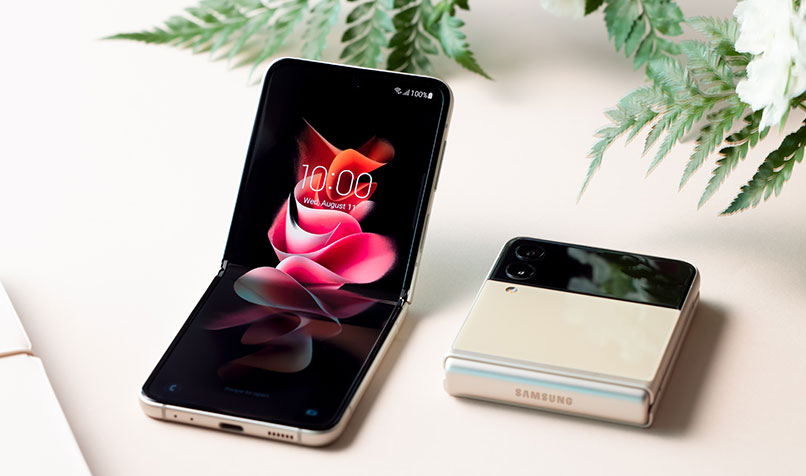Technology
What will the smartphone look like in 10 years?
Published
1 year agoon

About 10 years ago, no-one could imagine how much smartphones would evolve in a decade. However, smartphone technology has accelerated so much that the first smartphones now seem primitive.
Modern smartphones are now the platform of choice when it comes to accessing information. Years ago, we used countless devices to check the weather, take photos, read emails, or listen to music. However, today we find everything on our smartphone. Mobile phones have become an extension of ourselves, and have changed our lives forever. 80% of the world’s population has a cell phone and over a billion of these are smartphones.
Predictions for the Future of Smartphones
Foldable Future
Wouldn’t it be better if our phones could shrink to meet the work at hand? That is the promise of foldable devices.
Before foldable gadgets truly take off, a few issues must be resolved, beginning with the cost issue. The high price tag of the Samsung Galaxy Z Flip 3 brings folding phones closer to the public, but it’s still out of reach for many people. Manufacturers must be able to produce such folding components more efficiently and at a cheaper cost.
Another key problem is durability; foldable phones require more fragile displays, as well as hinges and moving parts that are considerably more difficult to seal against dust and water than typical candy bar-shaped phone components. Samsung has gotten inventive to make their folding phones more robust, but there will be many more solutions required for screens that roll and flex.
Over-the-air charging: Say goodbye to wired chargers
Many phones are dropping the 3.5mm headphone jack already, and they will be ancient history by 2030. We’ve already seen a few prototype phones without any ports, as handsets can rely on wireless charging to power up and Wi-Fi, mobile data or NFC options to send information and files to a computer.
It’s likely as wireless chargers get more popular and, more importantly, faster at powering up your device, that people will rely less on physical wires, making a port increasingly redundant. In that way, it echoes the use of wireless headphones, and in 2030 portless smartphones could be the new normal.
Smart Glasses
The most enticing prediction is that in 10 years, the handheld smartphone as we know it will be replaced — or at least relegated to our pockets — by smart eyeglasses.
We’re already on the right track, though early attempts like Google Glass were too rudimentary and odd-looking. More recent attempts, such as Focal, rely on the phone for far too much for their capabilities. Meta, the newly rebranded corporation behind Facebook, is still investigating this possibility, while Apple’s long-rumored mixed reality glasses are still in the works.
But it doesn’t take much to imagine a sleek future pair of fully independent smart glasses with lenses that double as private displays for things like our notifications, real-time AR directions, and video streaming. The main obstacle between existing and more capable smart glasses is being able to shrink all the necessary technology down into a pair that normal people would want to wear in public.
Holographic displays, no longer science fiction stuff
Holograms have appeared in recent science fiction and fantasy films such as Star Wars, Blade Runner 2049, I, Robot, and Iron Man.
Smartphones in 2030 may use holographic display technologies to render 3D pictures or films that float above the device and can be watched from any angle without the need for 3D glasses.
Smarter Artificial Intelligence
In the next ten years, Artificial Intelligence (AI) will become much more powerful and will play a critical role in our lives. AI is already a prominent element in today’s smartphones in areas like voice assistants, photography, augmented reality, and real-time language translation, and future gadgets will be even smarter, capable of making more complicated and human-like decisions.
It might even form the core of a suite of smart gadgets such as entertainment, connected cars, or home automation, capable of making restaurant reservations for you, recommending new activities, reading bedtime stories to the kids, managing your schedule, and organising your purchases.
What’s the future of the phone itself in this era of slowing sales?
Smartphone shipments fell more than 18% over the 2022 holiday season compared to the same period the previous year. In general, last year’s annual cargo total was the lowest since 2013. According to IDC, this is because of “significantly dampened consumer demand, inflation, and economic uncertainties.”
Smartphones are truly remarkable devices. That’s why they’re such a central part of our lives. It’s not even high-end devices, even mid-tier and entry-level devices have improved dramatically. Phones are also getting more repairable; why buy a new one when a better battery can be swapped in? This is perhaps why the used or refurbished market is growing.
Technologists, designers, analysts, and futurists hold their thoughts on what’s next for the smartphone. Some emphasised on the form factor, while others claim that advanced silicon will assist humans in distinguishing “real” media from fraudulent or AI-generated media. Nonetheless, almost all of them believe that the smartphone will continue to be something we carry with us, both literally and metaphorically. The smartphone market may never witness the same dramatic ascent that it saw in the 2010s, but the all-powerful pocket computer will be there for a long time.
Tony Fadell, Principal at Build Collective
I’m not a soothsayer, so I don’t know exactly what’s going to happen. But I do know what’s going on at the technology level. I think we’re going to continue to see better and better displays. Brighter colors and better power management and stuff like that. But also, the pixel density is going to be really great, and it’s going to be a question of, what else can you hide underneath the display?
Foldables will be a niche; they’re very expensive, and they’re going to continue to be bulkier because of the nature of mechanical systems. So, I think there will be a specific place or specific needs for those.
Anshel Sag, Analyst at Moor Insights & Strategy
I think in 10 years the smartphone will look very much like it does today. In the sense that the way we use it is still going to be very central to our daily lives. And the reason that I say that is because the form factor will really evolve. We’ve obviously landed on the candy bar design, and that will stick around for quite some time, but I do believe that the vast majority of the market will become foldable. So as the smartphone market shifts, people are going to be looking to get more utility out of that one device.
The mobile industry will continue to flow on expected capacity, but I don’t see a huge increase in growth unless at some point there’s a massive decline on a global scale. The important thing to consider is that there are opportunities in markets that are still underserved. Africa is one, where many of the phones in use are still feature phones, not full-fledged smartphones. There’s also potential in India’s 5G expansion. But I think we’re at a point where the smartphone market won’t swing drastically; it will behave a lot like the PC market, where you have years of slow growth and then sometimes economic conditions shrink sales.
It’s clear that smartphones will only get increasingly smarter. Thanks to a number of recent technological developments, it appears that there will be no shortage of new smartphone features in the future to keep us glued to our small digital devices.
You may like
-


Innodata: Championing Gender Diversity, Inclusion, and Equal Opportunity
-


How do you ensure that your leadership team embodies and models the desired behaviors and culture you want to cultivate?
-


Avani Lekhara wins gold medal at Paralympics with record-breaking score
-


Fostering a Culture of Continuous Learning and Development at Drychem
-


The Lifelong Advantage: Embracing Continuous Learning and Professional Development
-


Cyble: Setting the Benchmark as a Most Preferred Workplace Through Innovation, Well-being, and Employee-Centric Design


